Applying Critical Thinking in Treatment of Traumatic Brain Injury
VerifiedAdded on 2023/03/23
|12
|3330
|72
Case Study
AI Summary
This case study examines the application of critical thinking in the treatment of a patient with traumatic brain injury (TBI). It begins by outlining the different categories of TBI based on the Glasgow Coma Scale (GCS) and the symptoms associated with varying severity levels. The study focuses on a specific patient case, detailing the initial assessment, nursing considerations, and measures taken to prevent deterioration. It highlights instances where a lack of critical thinking by the attending nurse led to a worsening of the patient's condition. The case study then discusses the clinical review and resuscitation phases, emphasizing the importance of timely and appropriate interventions. Finally, it underscores the significance of critical thinking skills in nursing, including analytical, communication, and creative abilities, to ensure optimal patient recovery. The paper stresses the importance of thorough patient assessment, timely intervention, and continuous monitoring to prevent patient deterioration and improve outcomes in TBI cases.
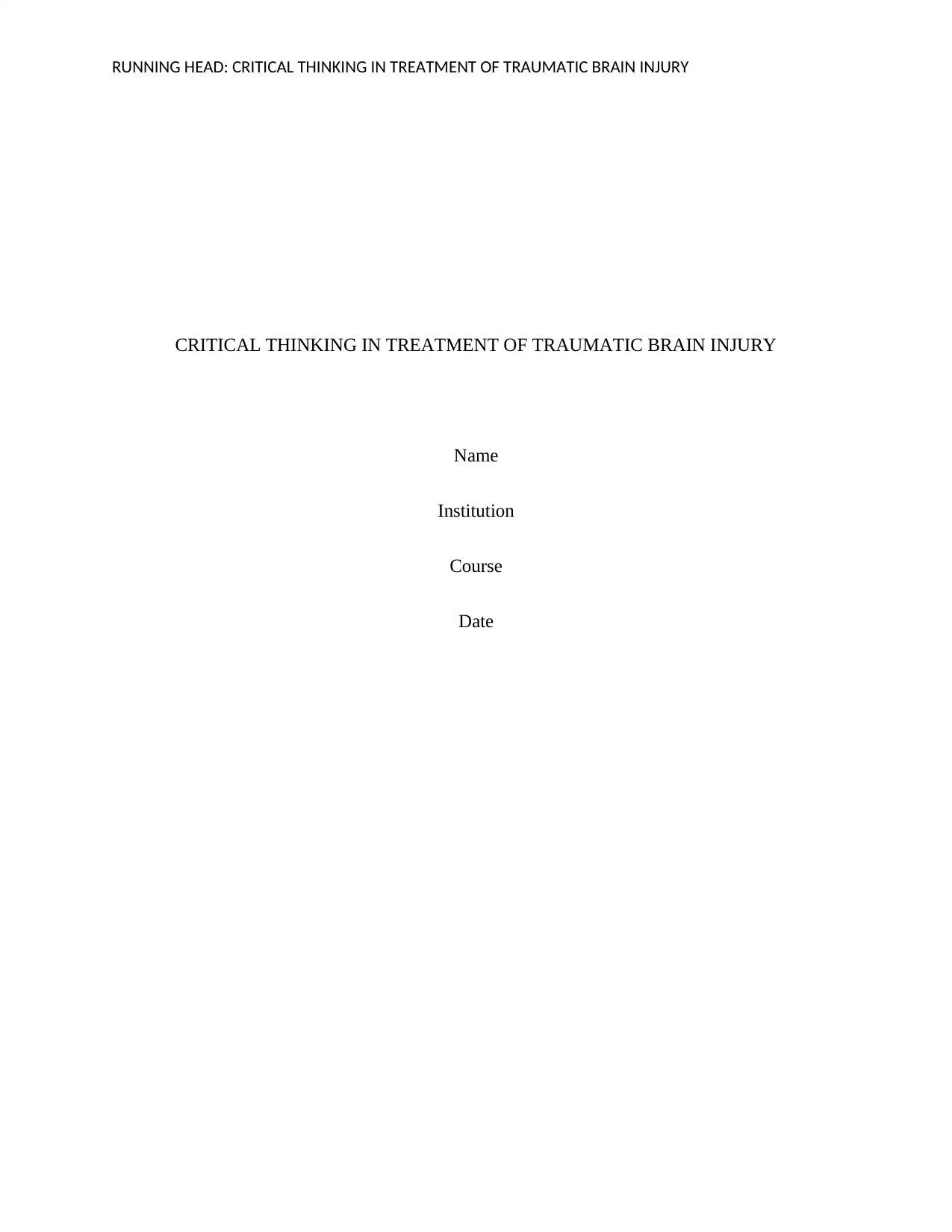
RUNNING HEAD: CRITICAL THINKING IN TREATMENT OF TRAUMATIC BRAIN INJURY
CRITICAL THINKING IN TREATMENT OF TRAUMATIC BRAIN INJURY
Name
Institution
Course
Date
CRITICAL THINKING IN TREATMENT OF TRAUMATIC BRAIN INJURY
Name
Institution
Course
Date
Paraphrase This Document
Need a fresh take? Get an instant paraphrase of this document with our AI Paraphraser
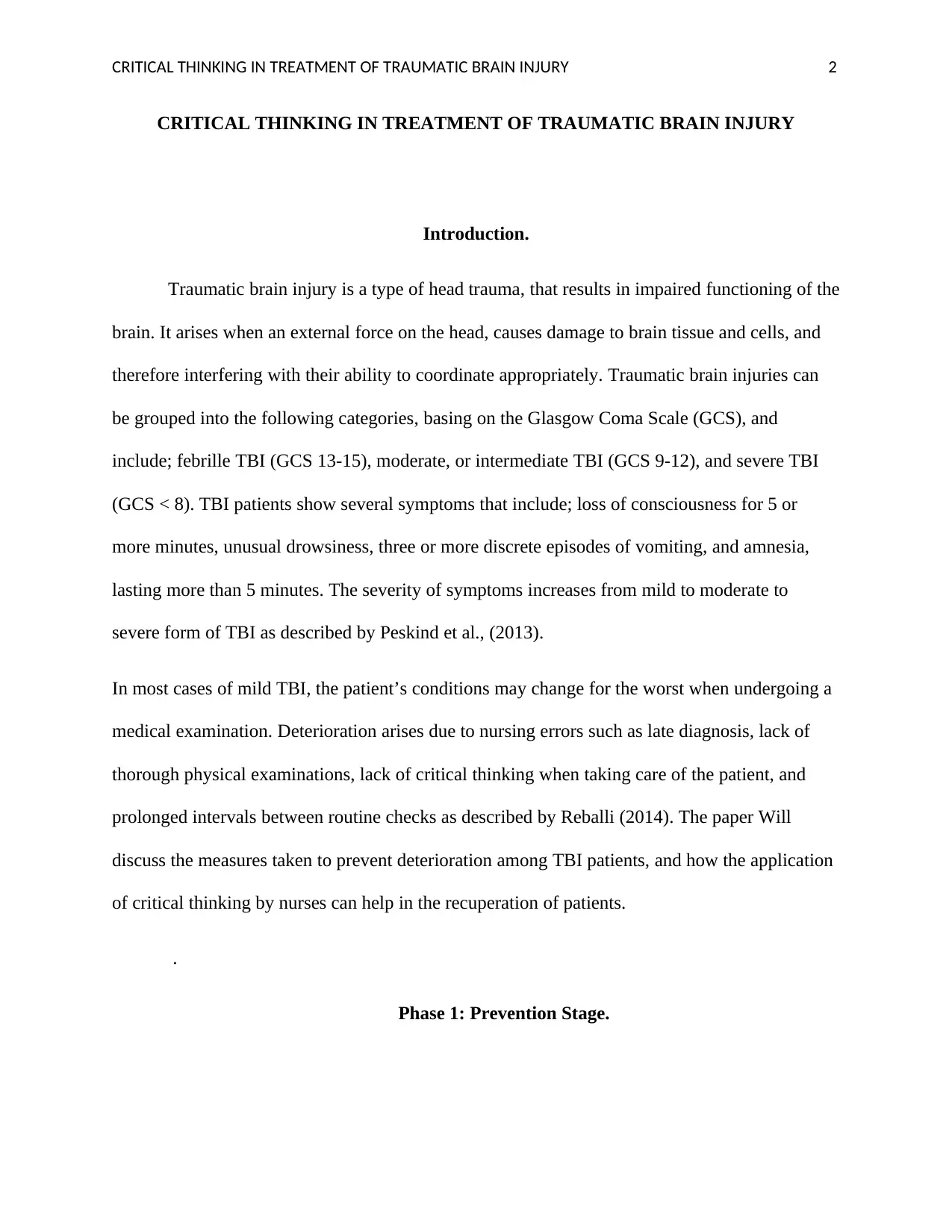
CRITICAL THINKING IN TREATMENT OF TRAUMATIC BRAIN INJURY 2
CRITICAL THINKING IN TREATMENT OF TRAUMATIC BRAIN INJURY
Introduction.
Traumatic brain injury is a type of head trauma, that results in impaired functioning of the
brain. It arises when an external force on the head, causes damage to brain tissue and cells, and
therefore interfering with their ability to coordinate appropriately. Traumatic brain injuries can
be grouped into the following categories, basing on the Glasgow Coma Scale (GCS), and
include; febrille TBI (GCS 13-15), moderate, or intermediate TBI (GCS 9-12), and severe TBI
(GCS < 8). TBI patients show several symptoms that include; loss of consciousness for 5 or
more minutes, unusual drowsiness, three or more discrete episodes of vomiting, and amnesia,
lasting more than 5 minutes. The severity of symptoms increases from mild to moderate to
severe form of TBI as described by Peskind et al., (2013).
In most cases of mild TBI, the patient’s conditions may change for the worst when undergoing a
medical examination. Deterioration arises due to nursing errors such as late diagnosis, lack of
thorough physical examinations, lack of critical thinking when taking care of the patient, and
prolonged intervals between routine checks as described by Reballi (2014). The paper Will
discuss the measures taken to prevent deterioration among TBI patients, and how the application
of critical thinking by nurses can help in the recuperation of patients.
.
Phase 1: Prevention Stage.
CRITICAL THINKING IN TREATMENT OF TRAUMATIC BRAIN INJURY
Introduction.
Traumatic brain injury is a type of head trauma, that results in impaired functioning of the
brain. It arises when an external force on the head, causes damage to brain tissue and cells, and
therefore interfering with their ability to coordinate appropriately. Traumatic brain injuries can
be grouped into the following categories, basing on the Glasgow Coma Scale (GCS), and
include; febrille TBI (GCS 13-15), moderate, or intermediate TBI (GCS 9-12), and severe TBI
(GCS < 8). TBI patients show several symptoms that include; loss of consciousness for 5 or
more minutes, unusual drowsiness, three or more discrete episodes of vomiting, and amnesia,
lasting more than 5 minutes. The severity of symptoms increases from mild to moderate to
severe form of TBI as described by Peskind et al., (2013).
In most cases of mild TBI, the patient’s conditions may change for the worst when undergoing a
medical examination. Deterioration arises due to nursing errors such as late diagnosis, lack of
thorough physical examinations, lack of critical thinking when taking care of the patient, and
prolonged intervals between routine checks as described by Reballi (2014). The paper Will
discuss the measures taken to prevent deterioration among TBI patients, and how the application
of critical thinking by nurses can help in the recuperation of patients.
.
Phase 1: Prevention Stage.
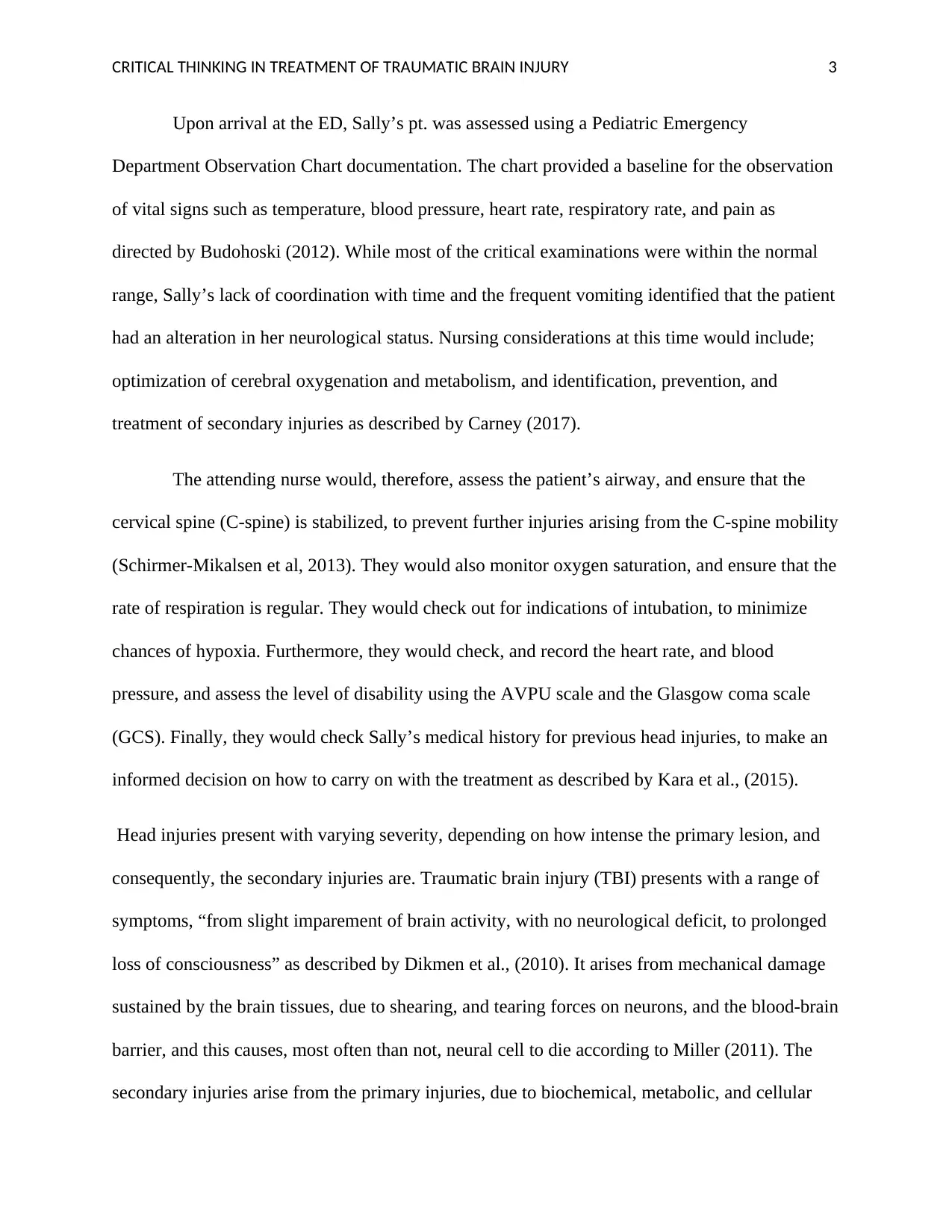
CRITICAL THINKING IN TREATMENT OF TRAUMATIC BRAIN INJURY 3
Upon arrival at the ED, Sally’s pt. was assessed using a Pediatric Emergency
Department Observation Chart documentation. The chart provided a baseline for the observation
of vital signs such as temperature, blood pressure, heart rate, respiratory rate, and pain as
directed by Budohoski (2012). While most of the critical examinations were within the normal
range, Sally’s lack of coordination with time and the frequent vomiting identified that the patient
had an alteration in her neurological status. Nursing considerations at this time would include;
optimization of cerebral oxygenation and metabolism, and identification, prevention, and
treatment of secondary injuries as described by Carney (2017).
The attending nurse would, therefore, assess the patient’s airway, and ensure that the
cervical spine (C-spine) is stabilized, to prevent further injuries arising from the C-spine mobility
(Schirmer‐Mikalsen et al, 2013). They would also monitor oxygen saturation, and ensure that the
rate of respiration is regular. They would check out for indications of intubation, to minimize
chances of hypoxia. Furthermore, they would check, and record the heart rate, and blood
pressure, and assess the level of disability using the AVPU scale and the Glasgow coma scale
(GCS). Finally, they would check Sally’s medical history for previous head injuries, to make an
informed decision on how to carry on with the treatment as described by Kara et al., (2015).
Head injuries present with varying severity, depending on how intense the primary lesion, and
consequently, the secondary injuries are. Traumatic brain injury (TBI) presents with a range of
symptoms, “from slight imparement of brain activity, with no neurological deficit, to prolonged
loss of consciousness” as described by Dikmen et al., (2010). It arises from mechanical damage
sustained by the brain tissues, due to shearing, and tearing forces on neurons, and the blood-brain
barrier, and this causes, most often than not, neural cell to die according to Miller (2011). The
secondary injuries arise from the primary injuries, due to biochemical, metabolic, and cellular
Upon arrival at the ED, Sally’s pt. was assessed using a Pediatric Emergency
Department Observation Chart documentation. The chart provided a baseline for the observation
of vital signs such as temperature, blood pressure, heart rate, respiratory rate, and pain as
directed by Budohoski (2012). While most of the critical examinations were within the normal
range, Sally’s lack of coordination with time and the frequent vomiting identified that the patient
had an alteration in her neurological status. Nursing considerations at this time would include;
optimization of cerebral oxygenation and metabolism, and identification, prevention, and
treatment of secondary injuries as described by Carney (2017).
The attending nurse would, therefore, assess the patient’s airway, and ensure that the
cervical spine (C-spine) is stabilized, to prevent further injuries arising from the C-spine mobility
(Schirmer‐Mikalsen et al, 2013). They would also monitor oxygen saturation, and ensure that the
rate of respiration is regular. They would check out for indications of intubation, to minimize
chances of hypoxia. Furthermore, they would check, and record the heart rate, and blood
pressure, and assess the level of disability using the AVPU scale and the Glasgow coma scale
(GCS). Finally, they would check Sally’s medical history for previous head injuries, to make an
informed decision on how to carry on with the treatment as described by Kara et al., (2015).
Head injuries present with varying severity, depending on how intense the primary lesion, and
consequently, the secondary injuries are. Traumatic brain injury (TBI) presents with a range of
symptoms, “from slight imparement of brain activity, with no neurological deficit, to prolonged
loss of consciousness” as described by Dikmen et al., (2010). It arises from mechanical damage
sustained by the brain tissues, due to shearing, and tearing forces on neurons, and the blood-brain
barrier, and this causes, most often than not, neural cell to die according to Miller (2011). The
secondary injuries arise from the primary injuries, due to biochemical, metabolic, and cellular
⊘ This is a preview!⊘
Do you want full access?
Subscribe today to unlock all pages.

Trusted by 1+ million students worldwide
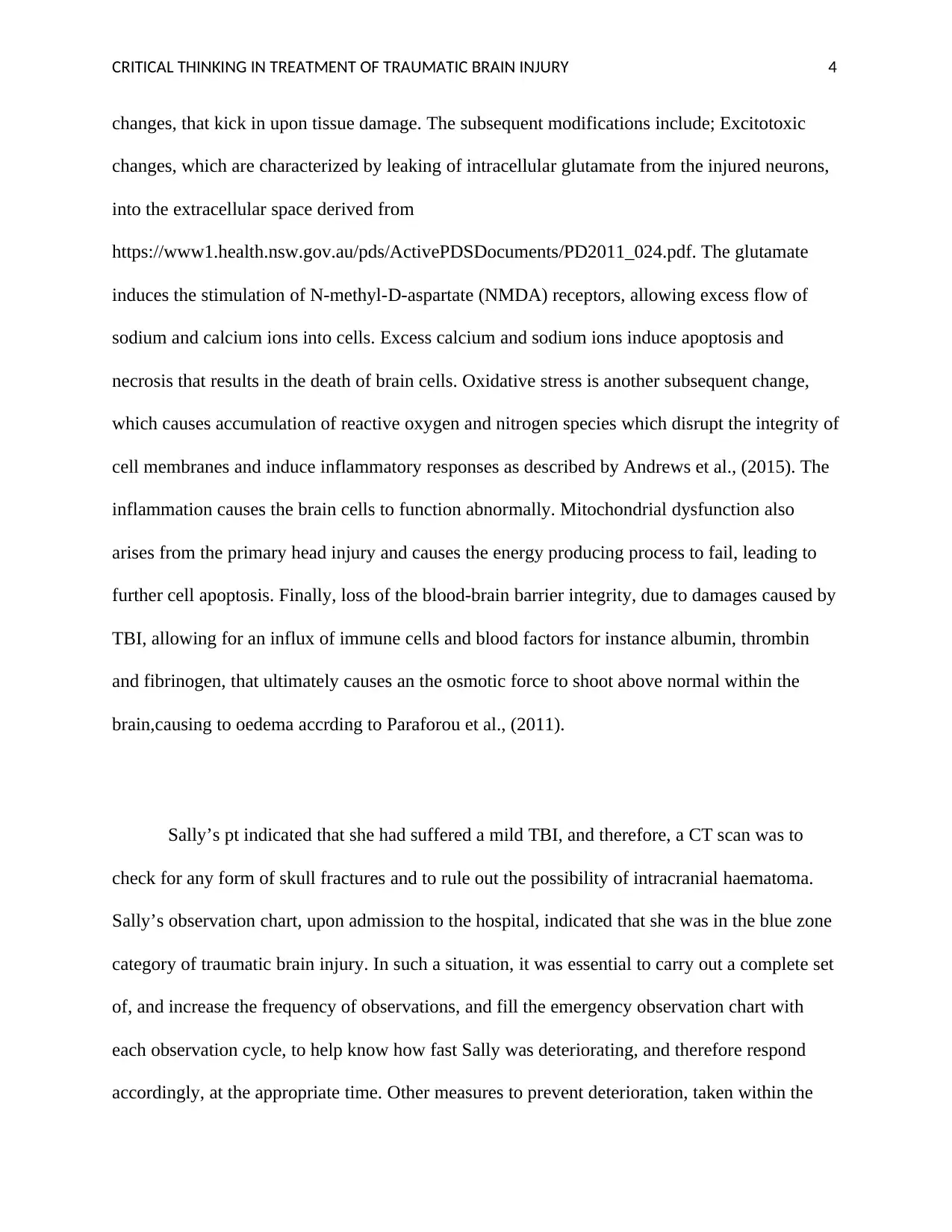
CRITICAL THINKING IN TREATMENT OF TRAUMATIC BRAIN INJURY 4
changes, that kick in upon tissue damage. The subsequent modifications include; Excitotoxic
changes, which are characterized by leaking of intracellular glutamate from the injured neurons,
into the extracellular space derived from
https://www1.health.nsw.gov.au/pds/ActivePDSDocuments/PD2011_024.pdf. The glutamate
induces the stimulation of N-methyl-D-aspartate (NMDA) receptors, allowing excess flow of
sodium and calcium ions into cells. Excess calcium and sodium ions induce apoptosis and
necrosis that results in the death of brain cells. Oxidative stress is another subsequent change,
which causes accumulation of reactive oxygen and nitrogen species which disrupt the integrity of
cell membranes and induce inflammatory responses as described by Andrews et al., (2015). The
inflammation causes the brain cells to function abnormally. Mitochondrial dysfunction also
arises from the primary head injury and causes the energy producing process to fail, leading to
further cell apoptosis. Finally, loss of the blood-brain barrier integrity, due to damages caused by
TBI, allowing for an influx of immune cells and blood factors for instance albumin, thrombin
and fibrinogen, that ultimately causes an the osmotic force to shoot above normal within the
brain,causing to oedema accrding to Paraforou et al., (2011).
Sally’s pt indicated that she had suffered a mild TBI, and therefore, a CT scan was to
check for any form of skull fractures and to rule out the possibility of intracranial haematoma.
Sally’s observation chart, upon admission to the hospital, indicated that she was in the blue zone
category of traumatic brain injury. In such a situation, it was essential to carry out a complete set
of, and increase the frequency of observations, and fill the emergency observation chart with
each observation cycle, to help know how fast Sally was deteriorating, and therefore respond
accordingly, at the appropriate time. Other measures to prevent deterioration, taken within the
changes, that kick in upon tissue damage. The subsequent modifications include; Excitotoxic
changes, which are characterized by leaking of intracellular glutamate from the injured neurons,
into the extracellular space derived from
https://www1.health.nsw.gov.au/pds/ActivePDSDocuments/PD2011_024.pdf. The glutamate
induces the stimulation of N-methyl-D-aspartate (NMDA) receptors, allowing excess flow of
sodium and calcium ions into cells. Excess calcium and sodium ions induce apoptosis and
necrosis that results in the death of brain cells. Oxidative stress is another subsequent change,
which causes accumulation of reactive oxygen and nitrogen species which disrupt the integrity of
cell membranes and induce inflammatory responses as described by Andrews et al., (2015). The
inflammation causes the brain cells to function abnormally. Mitochondrial dysfunction also
arises from the primary head injury and causes the energy producing process to fail, leading to
further cell apoptosis. Finally, loss of the blood-brain barrier integrity, due to damages caused by
TBI, allowing for an influx of immune cells and blood factors for instance albumin, thrombin
and fibrinogen, that ultimately causes an the osmotic force to shoot above normal within the
brain,causing to oedema accrding to Paraforou et al., (2011).
Sally’s pt indicated that she had suffered a mild TBI, and therefore, a CT scan was to
check for any form of skull fractures and to rule out the possibility of intracranial haematoma.
Sally’s observation chart, upon admission to the hospital, indicated that she was in the blue zone
category of traumatic brain injury. In such a situation, it was essential to carry out a complete set
of, and increase the frequency of observations, and fill the emergency observation chart with
each observation cycle, to help know how fast Sally was deteriorating, and therefore respond
accordingly, at the appropriate time. Other measures to prevent deterioration, taken within the
Paraphrase This Document
Need a fresh take? Get an instant paraphrase of this document with our AI Paraphraser
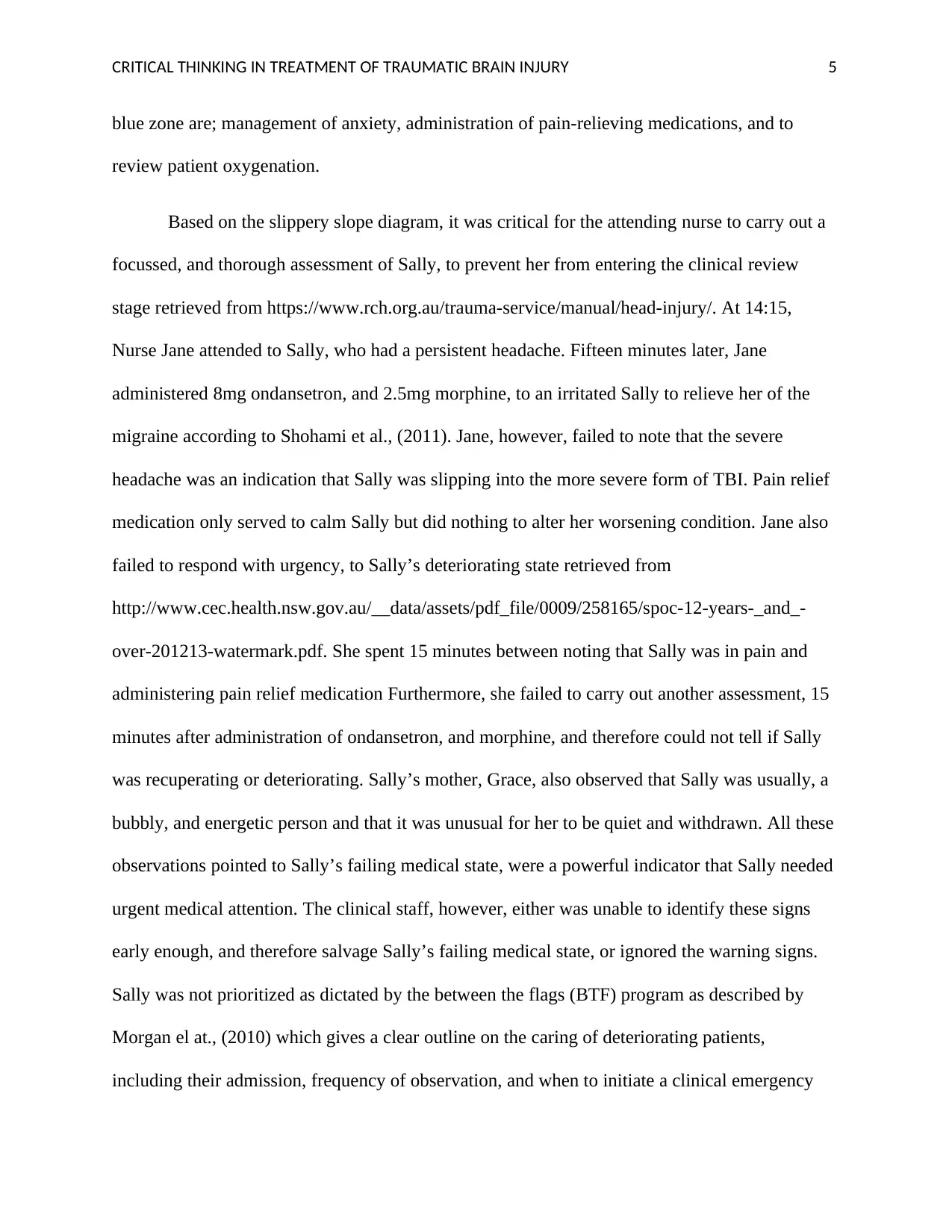
CRITICAL THINKING IN TREATMENT OF TRAUMATIC BRAIN INJURY 5
blue zone are; management of anxiety, administration of pain-relieving medications, and to
review patient oxygenation.
Based on the slippery slope diagram, it was critical for the attending nurse to carry out a
focussed, and thorough assessment of Sally, to prevent her from entering the clinical review
stage retrieved from https://www.rch.org.au/trauma-service/manual/head-injury/. At 14:15,
Nurse Jane attended to Sally, who had a persistent headache. Fifteen minutes later, Jane
administered 8mg ondansetron, and 2.5mg morphine, to an irritated Sally to relieve her of the
migraine according to Shohami et al., (2011). Jane, however, failed to note that the severe
headache was an indication that Sally was slipping into the more severe form of TBI. Pain relief
medication only served to calm Sally but did nothing to alter her worsening condition. Jane also
failed to respond with urgency, to Sally’s deteriorating state retrieved from
http://www.cec.health.nsw.gov.au/__data/assets/pdf_file/0009/258165/spoc-12-years-_and_-
over-201213-watermark.pdf. She spent 15 minutes between noting that Sally was in pain and
administering pain relief medication Furthermore, she failed to carry out another assessment, 15
minutes after administration of ondansetron, and morphine, and therefore could not tell if Sally
was recuperating or deteriorating. Sally’s mother, Grace, also observed that Sally was usually, a
bubbly, and energetic person and that it was unusual for her to be quiet and withdrawn. All these
observations pointed to Sally’s failing medical state, were a powerful indicator that Sally needed
urgent medical attention. The clinical staff, however, either was unable to identify these signs
early enough, and therefore salvage Sally’s failing medical state, or ignored the warning signs.
Sally was not prioritized as dictated by the between the flags (BTF) program as described by
Morgan el at., (2010) which gives a clear outline on the caring of deteriorating patients,
including their admission, frequency of observation, and when to initiate a clinical emergency
blue zone are; management of anxiety, administration of pain-relieving medications, and to
review patient oxygenation.
Based on the slippery slope diagram, it was critical for the attending nurse to carry out a
focussed, and thorough assessment of Sally, to prevent her from entering the clinical review
stage retrieved from https://www.rch.org.au/trauma-service/manual/head-injury/. At 14:15,
Nurse Jane attended to Sally, who had a persistent headache. Fifteen minutes later, Jane
administered 8mg ondansetron, and 2.5mg morphine, to an irritated Sally to relieve her of the
migraine according to Shohami et al., (2011). Jane, however, failed to note that the severe
headache was an indication that Sally was slipping into the more severe form of TBI. Pain relief
medication only served to calm Sally but did nothing to alter her worsening condition. Jane also
failed to respond with urgency, to Sally’s deteriorating state retrieved from
http://www.cec.health.nsw.gov.au/__data/assets/pdf_file/0009/258165/spoc-12-years-_and_-
over-201213-watermark.pdf. She spent 15 minutes between noting that Sally was in pain and
administering pain relief medication Furthermore, she failed to carry out another assessment, 15
minutes after administration of ondansetron, and morphine, and therefore could not tell if Sally
was recuperating or deteriorating. Sally’s mother, Grace, also observed that Sally was usually, a
bubbly, and energetic person and that it was unusual for her to be quiet and withdrawn. All these
observations pointed to Sally’s failing medical state, were a powerful indicator that Sally needed
urgent medical attention. The clinical staff, however, either was unable to identify these signs
early enough, and therefore salvage Sally’s failing medical state, or ignored the warning signs.
Sally was not prioritized as dictated by the between the flags (BTF) program as described by
Morgan el at., (2010) which gives a clear outline on the caring of deteriorating patients,
including their admission, frequency of observation, and when to initiate a clinical emergency
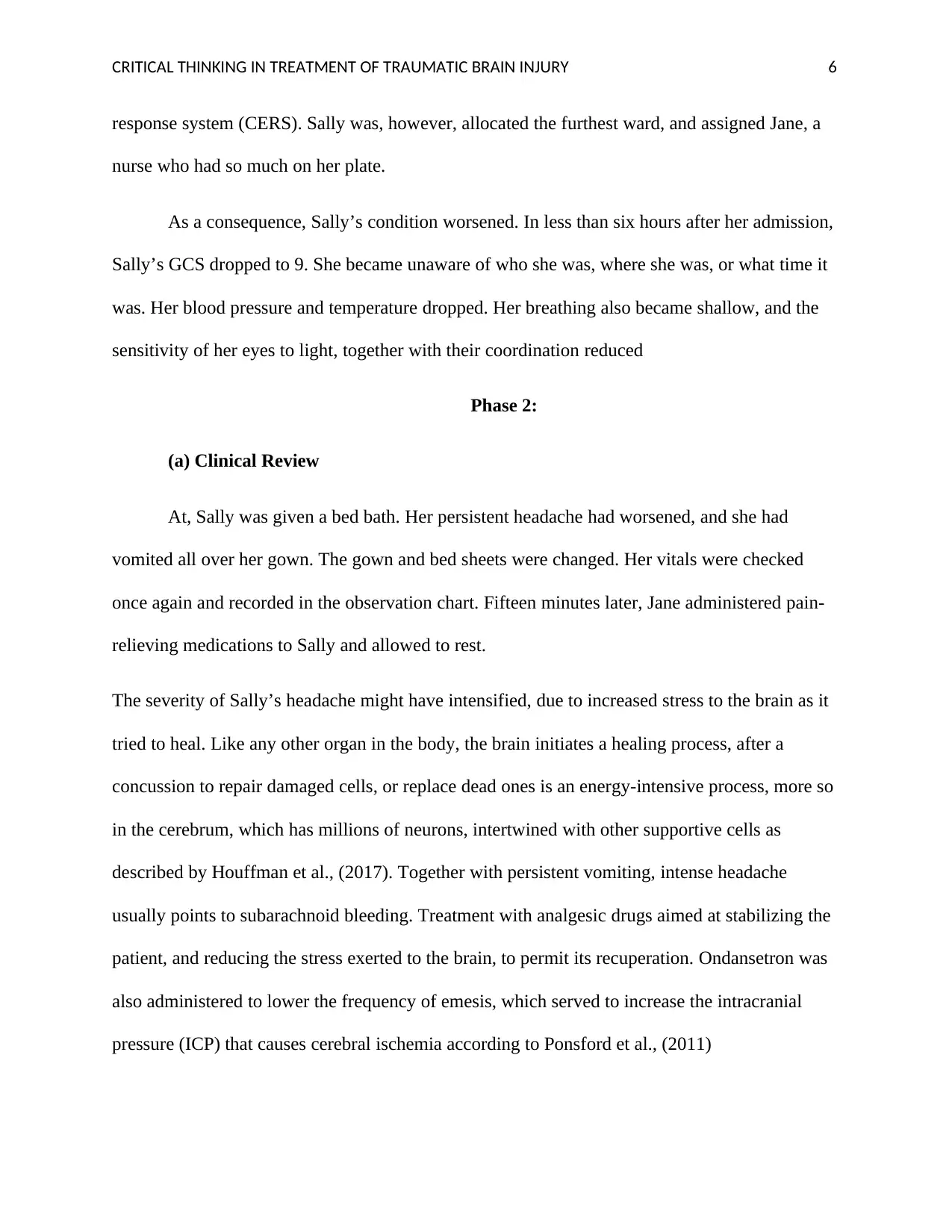
CRITICAL THINKING IN TREATMENT OF TRAUMATIC BRAIN INJURY 6
response system (CERS). Sally was, however, allocated the furthest ward, and assigned Jane, a
nurse who had so much on her plate.
As a consequence, Sally’s condition worsened. In less than six hours after her admission,
Sally’s GCS dropped to 9. She became unaware of who she was, where she was, or what time it
was. Her blood pressure and temperature dropped. Her breathing also became shallow, and the
sensitivity of her eyes to light, together with their coordination reduced
Phase 2:
(a) Clinical Review
At, Sally was given a bed bath. Her persistent headache had worsened, and she had
vomited all over her gown. The gown and bed sheets were changed. Her vitals were checked
once again and recorded in the observation chart. Fifteen minutes later, Jane administered pain-
relieving medications to Sally and allowed to rest.
The severity of Sally’s headache might have intensified, due to increased stress to the brain as it
tried to heal. Like any other organ in the body, the brain initiates a healing process, after a
concussion to repair damaged cells, or replace dead ones is an energy-intensive process, more so
in the cerebrum, which has millions of neurons, intertwined with other supportive cells as
described by Houffman et al., (2017). Together with persistent vomiting, intense headache
usually points to subarachnoid bleeding. Treatment with analgesic drugs aimed at stabilizing the
patient, and reducing the stress exerted to the brain, to permit its recuperation. Ondansetron was
also administered to lower the frequency of emesis, which served to increase the intracranial
pressure (ICP) that causes cerebral ischemia according to Ponsford et al., (2011)
response system (CERS). Sally was, however, allocated the furthest ward, and assigned Jane, a
nurse who had so much on her plate.
As a consequence, Sally’s condition worsened. In less than six hours after her admission,
Sally’s GCS dropped to 9. She became unaware of who she was, where she was, or what time it
was. Her blood pressure and temperature dropped. Her breathing also became shallow, and the
sensitivity of her eyes to light, together with their coordination reduced
Phase 2:
(a) Clinical Review
At, Sally was given a bed bath. Her persistent headache had worsened, and she had
vomited all over her gown. The gown and bed sheets were changed. Her vitals were checked
once again and recorded in the observation chart. Fifteen minutes later, Jane administered pain-
relieving medications to Sally and allowed to rest.
The severity of Sally’s headache might have intensified, due to increased stress to the brain as it
tried to heal. Like any other organ in the body, the brain initiates a healing process, after a
concussion to repair damaged cells, or replace dead ones is an energy-intensive process, more so
in the cerebrum, which has millions of neurons, intertwined with other supportive cells as
described by Houffman et al., (2017). Together with persistent vomiting, intense headache
usually points to subarachnoid bleeding. Treatment with analgesic drugs aimed at stabilizing the
patient, and reducing the stress exerted to the brain, to permit its recuperation. Ondansetron was
also administered to lower the frequency of emesis, which served to increase the intracranial
pressure (ICP) that causes cerebral ischemia according to Ponsford et al., (2011)
⊘ This is a preview!⊘
Do you want full access?
Subscribe today to unlock all pages.

Trusted by 1+ million students worldwide
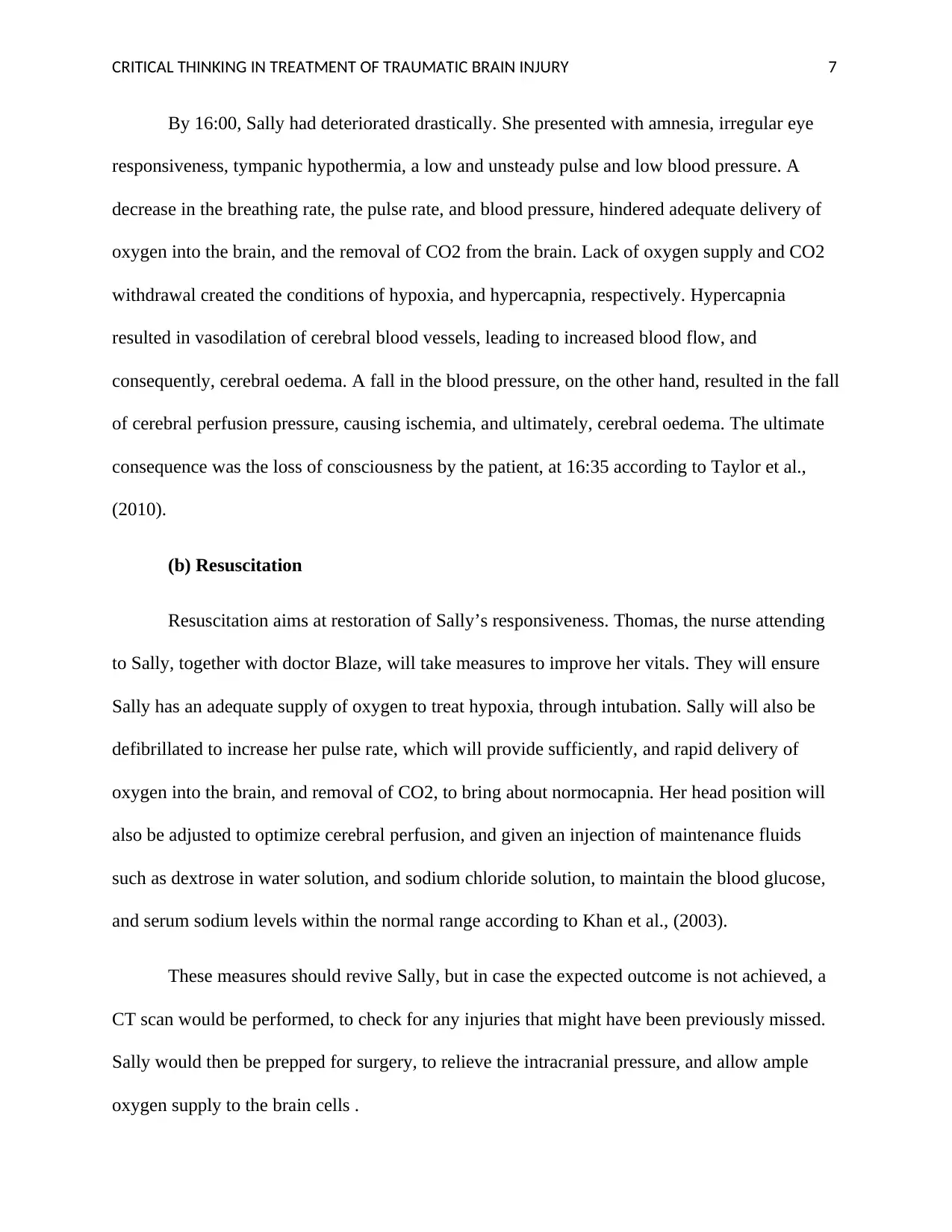
CRITICAL THINKING IN TREATMENT OF TRAUMATIC BRAIN INJURY 7
By 16:00, Sally had deteriorated drastically. She presented with amnesia, irregular eye
responsiveness, tympanic hypothermia, a low and unsteady pulse and low blood pressure. A
decrease in the breathing rate, the pulse rate, and blood pressure, hindered adequate delivery of
oxygen into the brain, and the removal of CO2 from the brain. Lack of oxygen supply and CO2
withdrawal created the conditions of hypoxia, and hypercapnia, respectively. Hypercapnia
resulted in vasodilation of cerebral blood vessels, leading to increased blood flow, and
consequently, cerebral oedema. A fall in the blood pressure, on the other hand, resulted in the fall
of cerebral perfusion pressure, causing ischemia, and ultimately, cerebral oedema. The ultimate
consequence was the loss of consciousness by the patient, at 16:35 according to Taylor et al.,
(2010).
(b) Resuscitation
Resuscitation aims at restoration of Sally’s responsiveness. Thomas, the nurse attending
to Sally, together with doctor Blaze, will take measures to improve her vitals. They will ensure
Sally has an adequate supply of oxygen to treat hypoxia, through intubation. Sally will also be
defibrillated to increase her pulse rate, which will provide sufficiently, and rapid delivery of
oxygen into the brain, and removal of CO2, to bring about normocapnia. Her head position will
also be adjusted to optimize cerebral perfusion, and given an injection of maintenance fluids
such as dextrose in water solution, and sodium chloride solution, to maintain the blood glucose,
and serum sodium levels within the normal range according to Khan et al., (2003).
These measures should revive Sally, but in case the expected outcome is not achieved, a
CT scan would be performed, to check for any injuries that might have been previously missed.
Sally would then be prepped for surgery, to relieve the intracranial pressure, and allow ample
oxygen supply to the brain cells .
By 16:00, Sally had deteriorated drastically. She presented with amnesia, irregular eye
responsiveness, tympanic hypothermia, a low and unsteady pulse and low blood pressure. A
decrease in the breathing rate, the pulse rate, and blood pressure, hindered adequate delivery of
oxygen into the brain, and the removal of CO2 from the brain. Lack of oxygen supply and CO2
withdrawal created the conditions of hypoxia, and hypercapnia, respectively. Hypercapnia
resulted in vasodilation of cerebral blood vessels, leading to increased blood flow, and
consequently, cerebral oedema. A fall in the blood pressure, on the other hand, resulted in the fall
of cerebral perfusion pressure, causing ischemia, and ultimately, cerebral oedema. The ultimate
consequence was the loss of consciousness by the patient, at 16:35 according to Taylor et al.,
(2010).
(b) Resuscitation
Resuscitation aims at restoration of Sally’s responsiveness. Thomas, the nurse attending
to Sally, together with doctor Blaze, will take measures to improve her vitals. They will ensure
Sally has an adequate supply of oxygen to treat hypoxia, through intubation. Sally will also be
defibrillated to increase her pulse rate, which will provide sufficiently, and rapid delivery of
oxygen into the brain, and removal of CO2, to bring about normocapnia. Her head position will
also be adjusted to optimize cerebral perfusion, and given an injection of maintenance fluids
such as dextrose in water solution, and sodium chloride solution, to maintain the blood glucose,
and serum sodium levels within the normal range according to Khan et al., (2003).
These measures should revive Sally, but in case the expected outcome is not achieved, a
CT scan would be performed, to check for any injuries that might have been previously missed.
Sally would then be prepped for surgery, to relieve the intracranial pressure, and allow ample
oxygen supply to the brain cells .
Paraphrase This Document
Need a fresh take? Get an instant paraphrase of this document with our AI Paraphraser
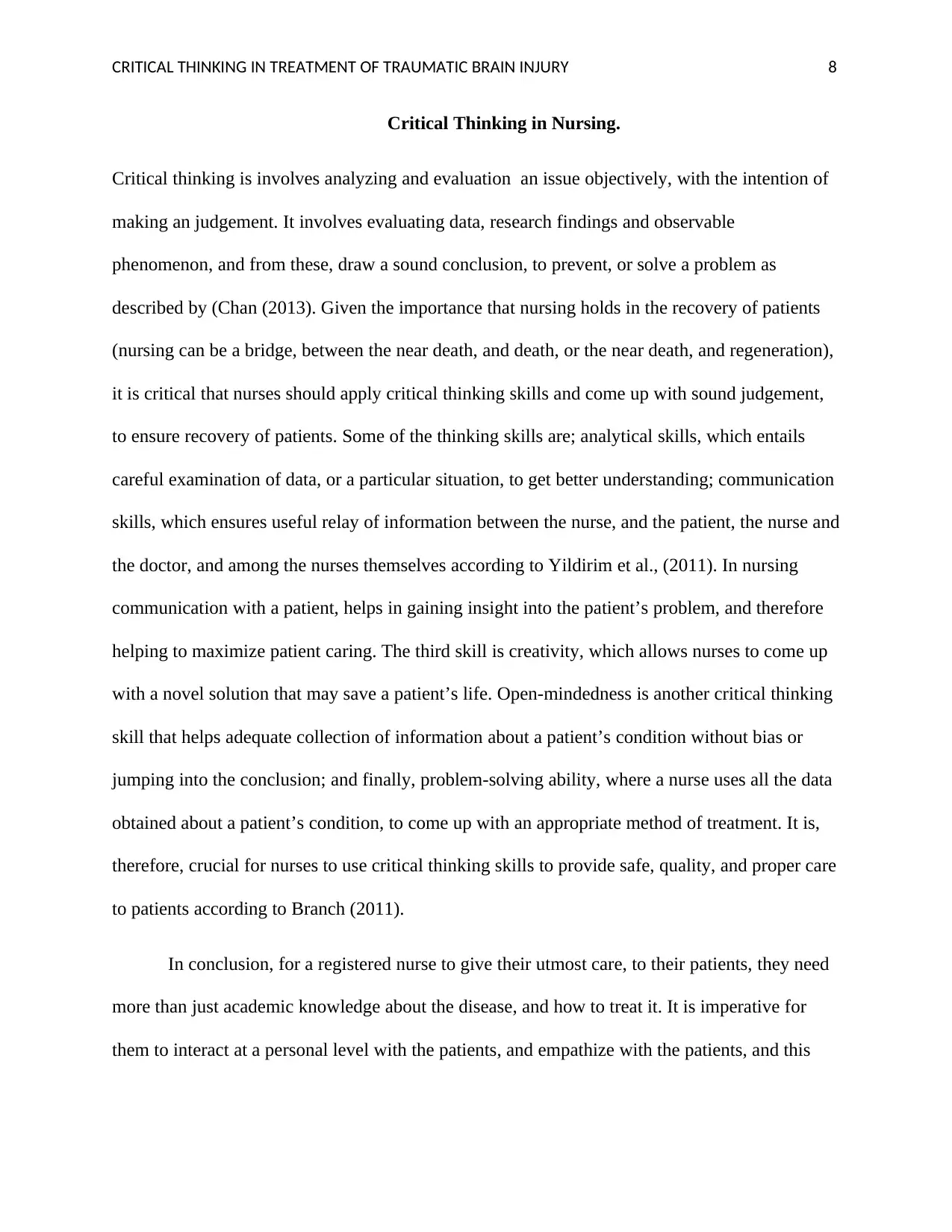
CRITICAL THINKING IN TREATMENT OF TRAUMATIC BRAIN INJURY 8
Critical Thinking in Nursing.
Critical thinking is involves analyzing and evaluation an issue objectively, with the intention of
making an judgement. It involves evaluating data, research findings and observable
phenomenon, and from these, draw a sound conclusion, to prevent, or solve a problem as
described by (Chan (2013). Given the importance that nursing holds in the recovery of patients
(nursing can be a bridge, between the near death, and death, or the near death, and regeneration),
it is critical that nurses should apply critical thinking skills and come up with sound judgement,
to ensure recovery of patients. Some of the thinking skills are; analytical skills, which entails
careful examination of data, or a particular situation, to get better understanding; communication
skills, which ensures useful relay of information between the nurse, and the patient, the nurse and
the doctor, and among the nurses themselves according to Yildirim et al., (2011). In nursing
communication with a patient, helps in gaining insight into the patient’s problem, and therefore
helping to maximize patient caring. The third skill is creativity, which allows nurses to come up
with a novel solution that may save a patient’s life. Open-mindedness is another critical thinking
skill that helps adequate collection of information about a patient’s condition without bias or
jumping into the conclusion; and finally, problem-solving ability, where a nurse uses all the data
obtained about a patient’s condition, to come up with an appropriate method of treatment. It is,
therefore, crucial for nurses to use critical thinking skills to provide safe, quality, and proper care
to patients according to Branch (2011).
In conclusion, for a registered nurse to give their utmost care, to their patients, they need
more than just academic knowledge about the disease, and how to treat it. It is imperative for
them to interact at a personal level with the patients, and empathize with the patients, and this
Critical Thinking in Nursing.
Critical thinking is involves analyzing and evaluation an issue objectively, with the intention of
making an judgement. It involves evaluating data, research findings and observable
phenomenon, and from these, draw a sound conclusion, to prevent, or solve a problem as
described by (Chan (2013). Given the importance that nursing holds in the recovery of patients
(nursing can be a bridge, between the near death, and death, or the near death, and regeneration),
it is critical that nurses should apply critical thinking skills and come up with sound judgement,
to ensure recovery of patients. Some of the thinking skills are; analytical skills, which entails
careful examination of data, or a particular situation, to get better understanding; communication
skills, which ensures useful relay of information between the nurse, and the patient, the nurse and
the doctor, and among the nurses themselves according to Yildirim et al., (2011). In nursing
communication with a patient, helps in gaining insight into the patient’s problem, and therefore
helping to maximize patient caring. The third skill is creativity, which allows nurses to come up
with a novel solution that may save a patient’s life. Open-mindedness is another critical thinking
skill that helps adequate collection of information about a patient’s condition without bias or
jumping into the conclusion; and finally, problem-solving ability, where a nurse uses all the data
obtained about a patient’s condition, to come up with an appropriate method of treatment. It is,
therefore, crucial for nurses to use critical thinking skills to provide safe, quality, and proper care
to patients according to Branch (2011).
In conclusion, for a registered nurse to give their utmost care, to their patients, they need
more than just academic knowledge about the disease, and how to treat it. It is imperative for
them to interact at a personal level with the patients, and empathize with the patients, and this

CRITICAL THINKING IN TREATMENT OF TRAUMATIC BRAIN INJURY 9
calls for critical thinking skills. A mistake on the side of the attending nurse puts in motion, a
cascade of events that can cause the worsening of the patient, or their death.
calls for critical thinking skills. A mistake on the side of the attending nurse puts in motion, a
cascade of events that can cause the worsening of the patient, or their death.
⊘ This is a preview!⊘
Do you want full access?
Subscribe today to unlock all pages.

Trusted by 1+ million students worldwide
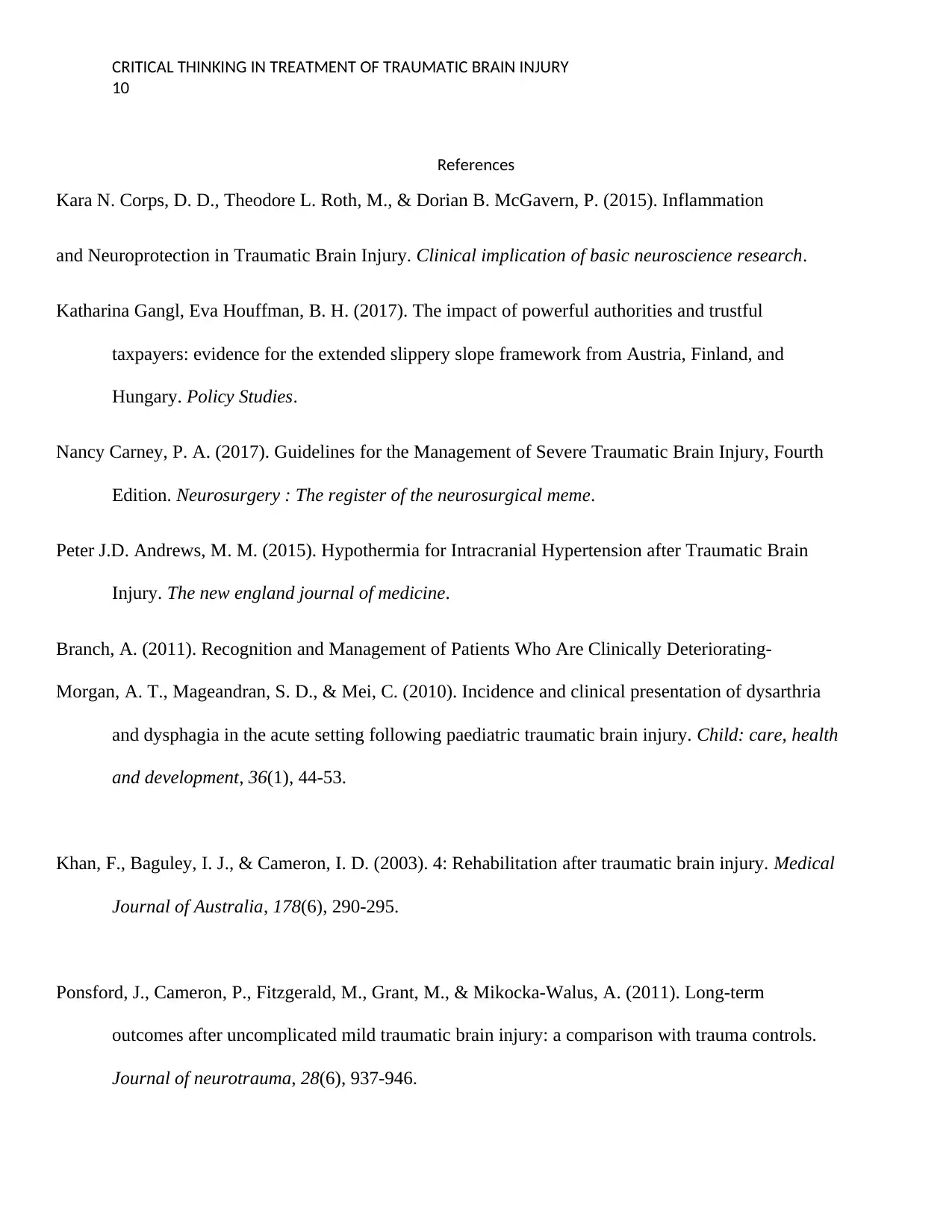
CRITICAL THINKING IN TREATMENT OF TRAUMATIC BRAIN INJURY
10
References
Kara N. Corps, D. D., Theodore L. Roth, M., & Dorian B. McGavern, P. (2015). Inflammation
and Neuroprotection in Traumatic Brain Injury. Clinical implication of basic neuroscience research.
Katharina Gangl, Eva Houffman, B. H. (2017). The impact of powerful authorities and trustful
taxpayers: evidence for the extended slippery slope framework from Austria, Finland, and
Hungary. Policy Studies.
Nancy Carney, P. A. (2017). Guidelines for the Management of Severe Traumatic Brain Injury, Fourth
Edition. Neurosurgery : The register of the neurosurgical meme.
Peter J.D. Andrews, M. M. (2015). Hypothermia for Intracranial Hypertension after Traumatic Brain
Injury. The new england journal of medicine.
Branch, A. (2011). Recognition and Management of Patients Who Are Clinically Deteriorating-
Morgan, A. T., Mageandran, S. D., & Mei, C. (2010). Incidence and clinical presentation of dysarthria
and dysphagia in the acute setting following paediatric traumatic brain injury. Child: care, health
and development, 36(1), 44-53.
Khan, F., Baguley, I. J., & Cameron, I. D. (2003). 4: Rehabilitation after traumatic brain injury. Medical
Journal of Australia, 178(6), 290-295.
Ponsford, J., Cameron, P., Fitzgerald, M., Grant, M., & Mikocka-Walus, A. (2011). Long-term
outcomes after uncomplicated mild traumatic brain injury: a comparison with trauma controls.
Journal of neurotrauma, 28(6), 937-946.
10
References
Kara N. Corps, D. D., Theodore L. Roth, M., & Dorian B. McGavern, P. (2015). Inflammation
and Neuroprotection in Traumatic Brain Injury. Clinical implication of basic neuroscience research.
Katharina Gangl, Eva Houffman, B. H. (2017). The impact of powerful authorities and trustful
taxpayers: evidence for the extended slippery slope framework from Austria, Finland, and
Hungary. Policy Studies.
Nancy Carney, P. A. (2017). Guidelines for the Management of Severe Traumatic Brain Injury, Fourth
Edition. Neurosurgery : The register of the neurosurgical meme.
Peter J.D. Andrews, M. M. (2015). Hypothermia for Intracranial Hypertension after Traumatic Brain
Injury. The new england journal of medicine.
Branch, A. (2011). Recognition and Management of Patients Who Are Clinically Deteriorating-
Morgan, A. T., Mageandran, S. D., & Mei, C. (2010). Incidence and clinical presentation of dysarthria
and dysphagia in the acute setting following paediatric traumatic brain injury. Child: care, health
and development, 36(1), 44-53.
Khan, F., Baguley, I. J., & Cameron, I. D. (2003). 4: Rehabilitation after traumatic brain injury. Medical
Journal of Australia, 178(6), 290-295.
Ponsford, J., Cameron, P., Fitzgerald, M., Grant, M., & Mikocka-Walus, A. (2011). Long-term
outcomes after uncomplicated mild traumatic brain injury: a comparison with trauma controls.
Journal of neurotrauma, 28(6), 937-946.
Paraphrase This Document
Need a fresh take? Get an instant paraphrase of this document with our AI Paraphraser
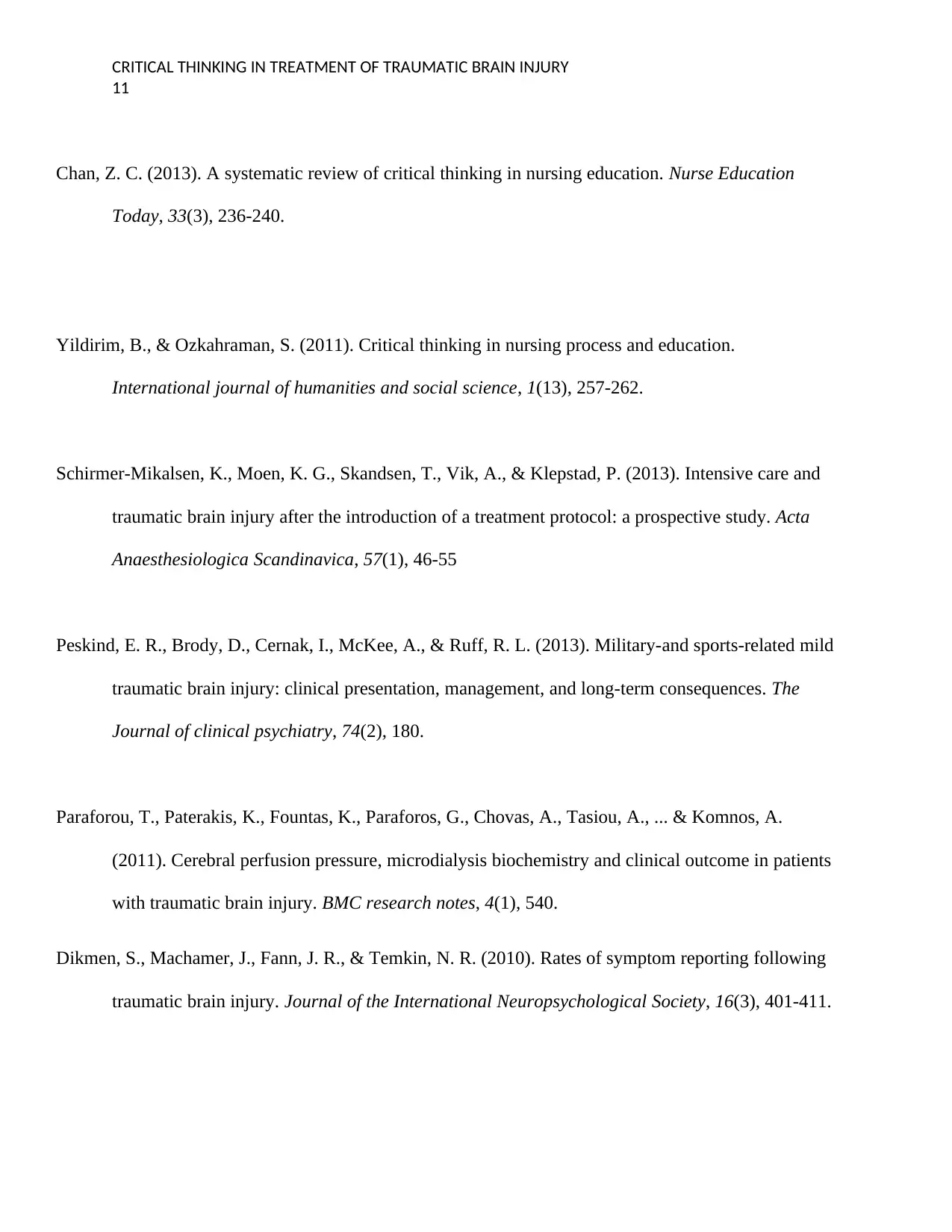
CRITICAL THINKING IN TREATMENT OF TRAUMATIC BRAIN INJURY
11
Chan, Z. C. (2013). A systematic review of critical thinking in nursing education. Nurse Education
Today, 33(3), 236-240.
Yildirim, B., & Ozkahraman, S. (2011). Critical thinking in nursing process and education.
International journal of humanities and social science, 1(13), 257-262.
Schirmer‐Mikalsen, K., Moen, K. G., Skandsen, T., Vik, A., & Klepstad, P. (2013). Intensive care and
traumatic brain injury after the introduction of a treatment protocol: a prospective study. Acta
Anaesthesiologica Scandinavica, 57(1), 46-55
Peskind, E. R., Brody, D., Cernak, I., McKee, A., & Ruff, R. L. (2013). Military-and sports-related mild
traumatic brain injury: clinical presentation, management, and long-term consequences. The
Journal of clinical psychiatry, 74(2), 180.
Paraforou, T., Paterakis, K., Fountas, K., Paraforos, G., Chovas, A., Tasiou, A., ... & Komnos, A.
(2011). Cerebral perfusion pressure, microdialysis biochemistry and clinical outcome in patients
with traumatic brain injury. BMC research notes, 4(1), 540.
Dikmen, S., Machamer, J., Fann, J. R., & Temkin, N. R. (2010). Rates of symptom reporting following
traumatic brain injury. Journal of the International Neuropsychological Society, 16(3), 401-411.
11
Chan, Z. C. (2013). A systematic review of critical thinking in nursing education. Nurse Education
Today, 33(3), 236-240.
Yildirim, B., & Ozkahraman, S. (2011). Critical thinking in nursing process and education.
International journal of humanities and social science, 1(13), 257-262.
Schirmer‐Mikalsen, K., Moen, K. G., Skandsen, T., Vik, A., & Klepstad, P. (2013). Intensive care and
traumatic brain injury after the introduction of a treatment protocol: a prospective study. Acta
Anaesthesiologica Scandinavica, 57(1), 46-55
Peskind, E. R., Brody, D., Cernak, I., McKee, A., & Ruff, R. L. (2013). Military-and sports-related mild
traumatic brain injury: clinical presentation, management, and long-term consequences. The
Journal of clinical psychiatry, 74(2), 180.
Paraforou, T., Paterakis, K., Fountas, K., Paraforos, G., Chovas, A., Tasiou, A., ... & Komnos, A.
(2011). Cerebral perfusion pressure, microdialysis biochemistry and clinical outcome in patients
with traumatic brain injury. BMC research notes, 4(1), 540.
Dikmen, S., Machamer, J., Fann, J. R., & Temkin, N. R. (2010). Rates of symptom reporting following
traumatic brain injury. Journal of the International Neuropsychological Society, 16(3), 401-411.
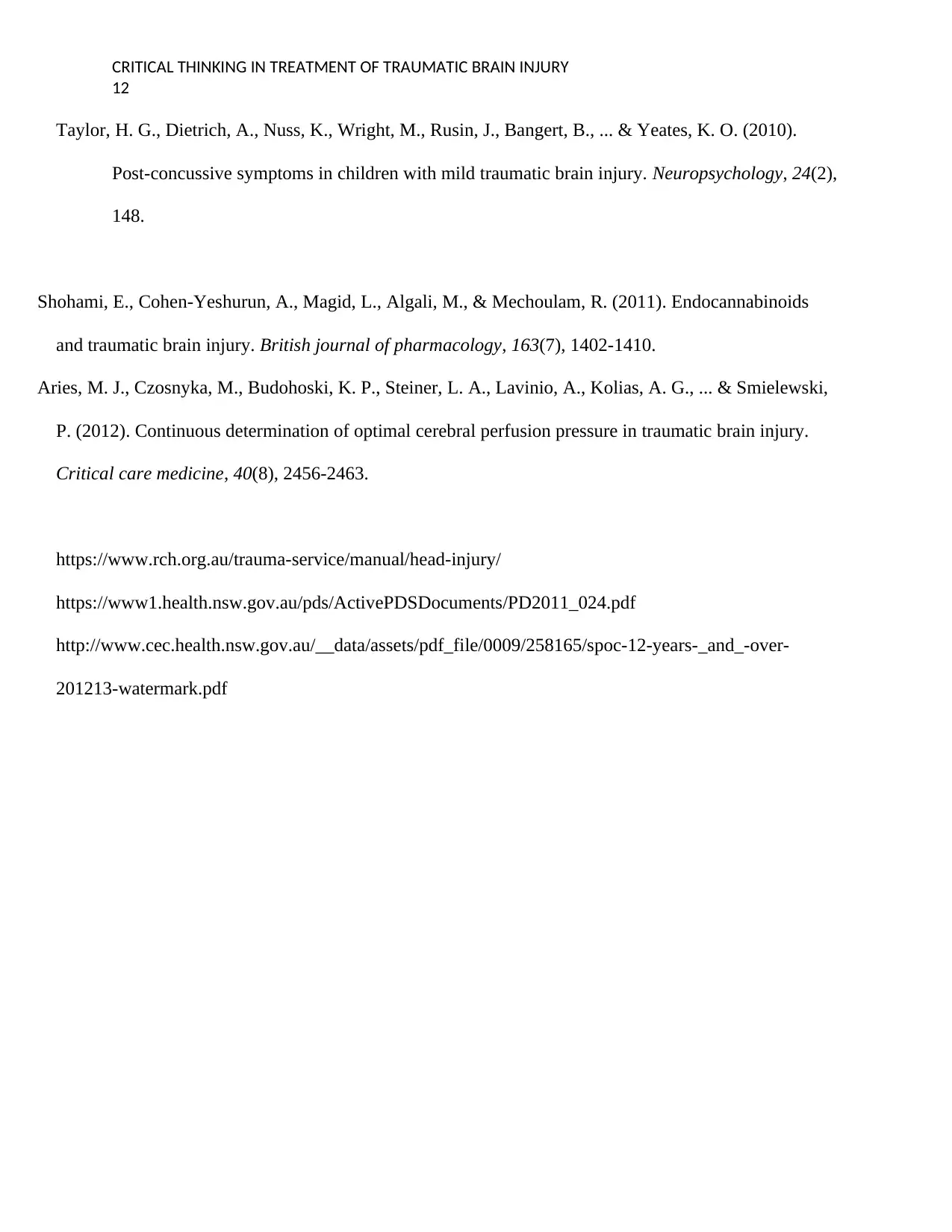
CRITICAL THINKING IN TREATMENT OF TRAUMATIC BRAIN INJURY
12
Taylor, H. G., Dietrich, A., Nuss, K., Wright, M., Rusin, J., Bangert, B., ... & Yeates, K. O. (2010).
Post-concussive symptoms in children with mild traumatic brain injury. Neuropsychology, 24(2),
148.
Shohami, E., Cohen‐Yeshurun, A., Magid, L., Algali, M., & Mechoulam, R. (2011). Endocannabinoids
and traumatic brain injury. British journal of pharmacology, 163(7), 1402-1410.
Aries, M. J., Czosnyka, M., Budohoski, K. P., Steiner, L. A., Lavinio, A., Kolias, A. G., ... & Smielewski,
P. (2012). Continuous determination of optimal cerebral perfusion pressure in traumatic brain injury.
Critical care medicine, 40(8), 2456-2463.
https://www.rch.org.au/trauma-service/manual/head-injury/
https://www1.health.nsw.gov.au/pds/ActivePDSDocuments/PD2011_024.pdf
http://www.cec.health.nsw.gov.au/__data/assets/pdf_file/0009/258165/spoc-12-years-_and_-over-
201213-watermark.pdf
12
Taylor, H. G., Dietrich, A., Nuss, K., Wright, M., Rusin, J., Bangert, B., ... & Yeates, K. O. (2010).
Post-concussive symptoms in children with mild traumatic brain injury. Neuropsychology, 24(2),
148.
Shohami, E., Cohen‐Yeshurun, A., Magid, L., Algali, M., & Mechoulam, R. (2011). Endocannabinoids
and traumatic brain injury. British journal of pharmacology, 163(7), 1402-1410.
Aries, M. J., Czosnyka, M., Budohoski, K. P., Steiner, L. A., Lavinio, A., Kolias, A. G., ... & Smielewski,
P. (2012). Continuous determination of optimal cerebral perfusion pressure in traumatic brain injury.
Critical care medicine, 40(8), 2456-2463.
https://www.rch.org.au/trauma-service/manual/head-injury/
https://www1.health.nsw.gov.au/pds/ActivePDSDocuments/PD2011_024.pdf
http://www.cec.health.nsw.gov.au/__data/assets/pdf_file/0009/258165/spoc-12-years-_and_-over-
201213-watermark.pdf
⊘ This is a preview!⊘
Do you want full access?
Subscribe today to unlock all pages.

Trusted by 1+ million students worldwide
1 out of 12
Related Documents
Your All-in-One AI-Powered Toolkit for Academic Success.
+13062052269
info@desklib.com
Available 24*7 on WhatsApp / Email
![[object Object]](/_next/static/media/star-bottom.7253800d.svg)
Unlock your academic potential
Copyright © 2020–2025 A2Z Services. All Rights Reserved. Developed and managed by ZUCOL.





